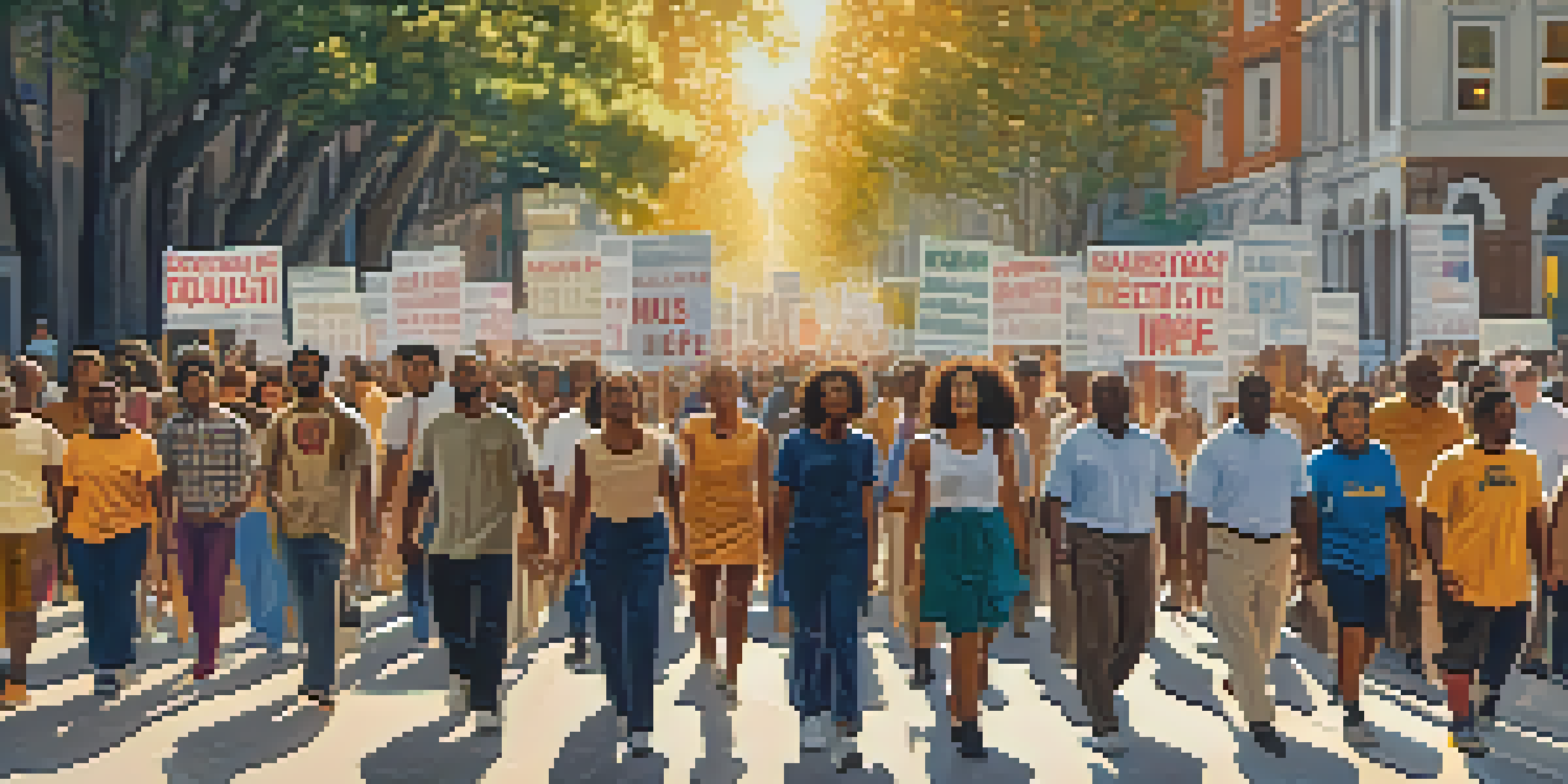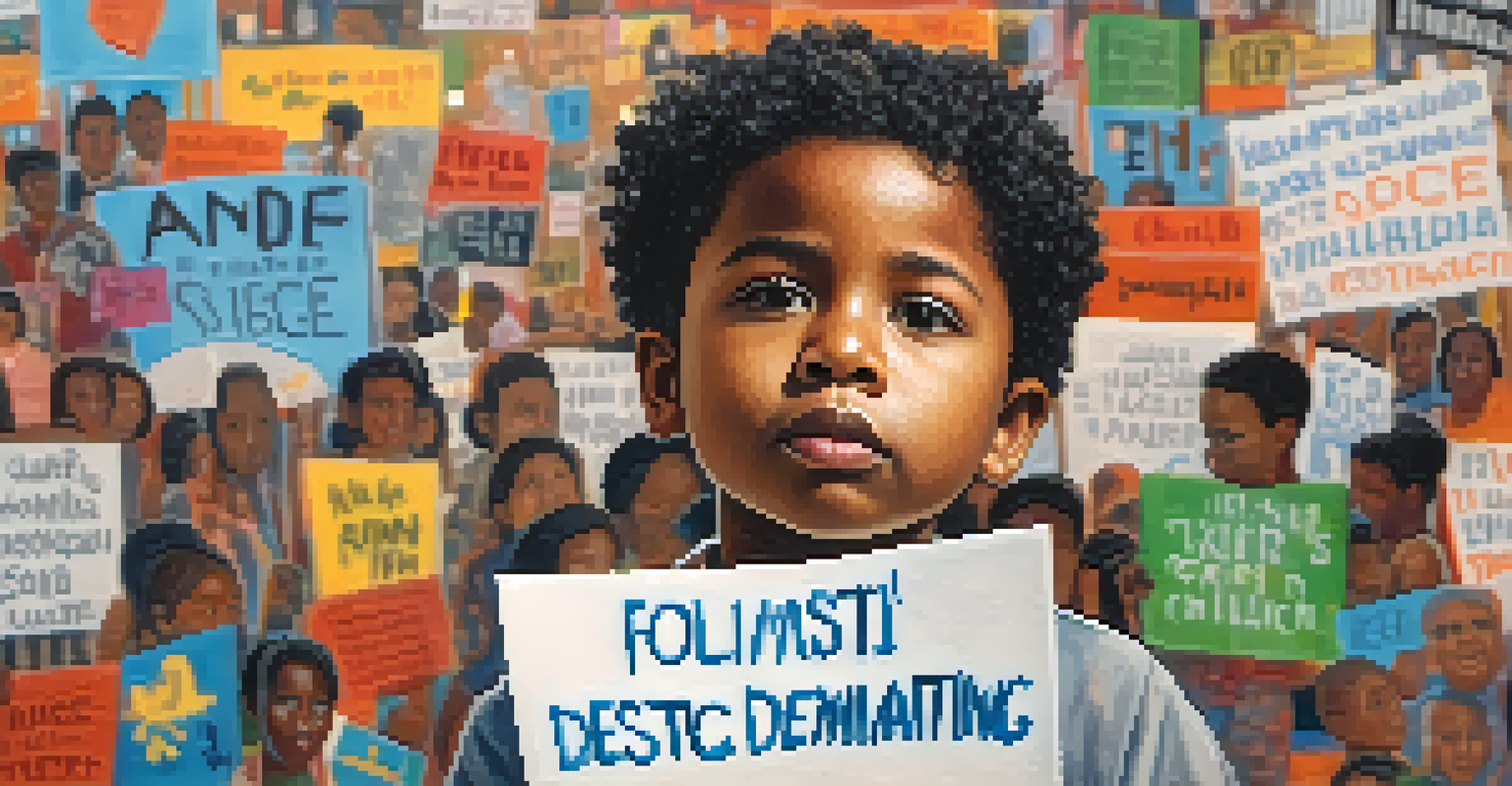How Hollywood's Depictions of Civil Rights Movements Evolve

The Early Years: Simplistic Narratives of Civil Rights
In the early days of Hollywood, depictions of civil rights movements often fell into simplistic narratives. Movies like 'To Kill a Mockingbird' presented a black-and-white view of racial injustice, focusing primarily on moral absolutes. These films typically centered around heroic figures standing against the prevailing tide of racism, which, while inspiring, often oversimplified the complexities of the struggle for civil rights.
The cinema is a mirror of society, and it is important that we reflect the diversity and complexities of the world we live in.
During this time, the focus was more on individual characters rather than systemic issues, which meant that the broader societal context was often overlooked. This could lead to a sense of closure that didn't reflect the ongoing battles faced by those fighting for equality. As a result, audiences were left with an incomplete understanding of the struggles at hand.
Furthermore, these early portrayals were heavily influenced by the social climate of the era, often reflecting the desires of a predominantly white audience. This meant that many stories were filtered through a lens that didn't resonate with the lived experiences of those in marginalized communities, leaving a gap in authentic representation.
The 1960s and 1970s: A Shift Towards Authenticity
The civil rights movements of the 1960s and 1970s marked a significant shift in Hollywood's approach to storytelling. Films began to feature more authentic representations of black voices and experiences, as seen in works like 'Malcolm X' and 'Selma.' These films not only highlighted key figures but also showcased the collective struggle of communities, giving audiences a more nuanced perspective.

This era also saw the emergence of documentaries that brought real footage and testimony into the mix, providing a stark contrast to the dramatized versions of events. These films invited viewers to engage with the harsh realities of racism and oppression, making it harder to ignore the urgent social issues at hand. This authenticity resonated deeply, as many audiences began to demand more accurate portrayals of marginalized groups.
Hollywood's Evolving Civil Rights Narratives
The portrayal of civil rights in Hollywood has transformed from simplistic narratives to more authentic representations reflecting diverse voices and experiences.
However, while this shift was promising, it wasn't without its challenges. Filmmakers often faced pushback from studios and audiences alike, who were uncomfortable with the raw and unfiltered depictions of racial violence and injustice. Nevertheless, this period laid the groundwork for more inclusive storytelling in Hollywood.
The 1980s and 1990s: Commercialization and Stereotypes
As Hollywood entered the 1980s and 1990s, the commercialization of civil rights narratives began to emerge. Films like 'The Color Purple' and 'Malcolm X' gained critical acclaim but also faced scrutiny for how they packaged complex histories for mass consumption. This commercialization sometimes resulted in a focus on individual stories rather than collective struggles, risking the dilution of important messages.
Films can only be as good as the ideas they explore and the stories they tell. We need to take ownership of our narratives.
Moreover, the portrayal of black characters often fell into stereotypical roles, perpetuating harmful tropes rather than fostering understanding. While these films did bring attention to civil rights issues, they sometimes did so at the expense of a deeper, more meaningful engagement with the topics at hand. This led to a mixed reception among audiences who craved more authentic narratives.
Despite these challenges, this period also saw the rise of influential filmmakers and actors who sought to challenge these stereotypes. Spike Lee, for example, used his platform to address social issues more directly, paving the way for future generations of filmmakers to tell their stories in their own ways.
The 21st Century: Diverse Perspectives and New Narratives
Moving into the 21st century, Hollywood has begun to embrace a broader range of voices and perspectives in its storytelling. Films like '12 Years a Slave' and 'Black Panther' not only highlight the historical struggles surrounding civil rights but also celebrate the richness of black culture and identity. This shift reflects a growing recognition of the importance of diversity both in front of and behind the camera.
Moreover, the rise of streaming platforms has expanded the landscape for storytelling, allowing for more niche narratives to flourish. Independent films and series are increasingly exploring the intricacies of racial identity and the ongoing fight for equality. This democratization of content has empowered creators to tell stories that resonate with their communities, further enriching the cinematic landscape.
Documentaries Drive Social Change
Documentaries like '13th' and 'I Am Not Your Negro' offer powerful insights into systemic racism, serving as educational tools that provoke critical discussions about justice.
However, the challenge remains for the industry to continue moving beyond tokenism and to authentically represent the multiplicity of experiences within the civil rights movement. Audiences are increasingly savvy and demand more than just surface-level engagement with these vital issues, pushing Hollywood to evolve continuously.
Documentaries: A Powerful Tool for Social Change
Documentaries have emerged as a crucial medium for exploring civil rights movements, offering a raw and real perspective that dramatized films often cannot. Works like '13th' and 'I Am Not Your Negro' provide powerful commentary on systemic racism and the historical context of civil rights struggles. These films challenge viewers to confront uncomfortable truths and engage in critical discussions about race and justice.
The impact of these documentaries extends beyond mere entertainment; they serve as educational tools that can influence public perception and policy. By presenting factual accounts and personal testimonies, filmmakers can evoke empathy and create a sense of urgency around social issues. This has sparked movements and dialogues that resonate far beyond the screen.
However, while the power of documentaries is undeniable, they still require careful consideration in how stories are told. Filmmakers must navigate the line between advocacy and storytelling to ensure that their messages are impactful without being preachy. Striking this balance is essential for fostering genuine engagement with civil rights narratives.
The Role of Audience in Shaping Civil Rights Narratives
The evolution of civil rights depictions in Hollywood is not solely the work of filmmakers; audiences play a pivotal role in shaping these narratives. As viewers become more aware of social justice issues, they demand authenticity and representation in the stories being told. This shift has led to a growing number of projects that explore the complexities of race and identity, reflecting the diverse experiences of marginalized communities.
Social media has become a powerful platform for audiences to voice their opinions and drive change. Movements like #OscarsSoWhite highlight the need for greater diversity in the film industry, pushing Hollywood to recognize the importance of inclusive storytelling. As a result, studios are increasingly seeking out diverse voices and perspectives to create more authentic and relatable narratives.
Audience Demands Authentic Representation
As audiences become more aware of social justice issues, they increasingly demand authentic and diverse storytelling, influencing Hollywood to adapt and evolve.
Ultimately, the relationship between Hollywood and its audience is symbiotic; as filmmakers respond to the demands for equity and representation, audiences become more engaged and informed. This dynamic ensures that the evolution of civil rights depictions continues to progress, reflecting the ongoing fight for equality.
Looking Ahead: The Future of Civil Rights in Hollywood
As we look to the future, the evolution of civil rights portrayals in Hollywood will likely continue to reflect societal changes. With a growing emphasis on diversity and inclusion, filmmakers are better equipped to tell nuanced stories that resonate with a wider audience. The push for authentic representation will likely drive more innovative narratives that explore the intersectionality of various social justice issues.
Moreover, the increasing influence of global cinema means that American filmmakers will be exposed to a broader range of storytelling techniques and cultural perspectives. This could lead to more collaborative projects that highlight the universal nature of civil rights struggles, transcending geographical boundaries. Such exchanges can enrich the storytelling landscape and inspire audiences worldwide.

While challenges remain, the ongoing dialogue around civil rights in Hollywood signals a promising future. As both creators and audiences continue to engage with these vital narratives, we can hope for a media landscape that reflects the complexity and richness of the human experience in the fight for equality.